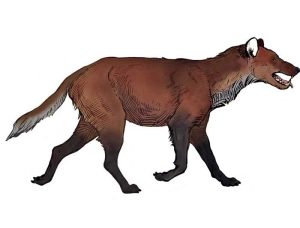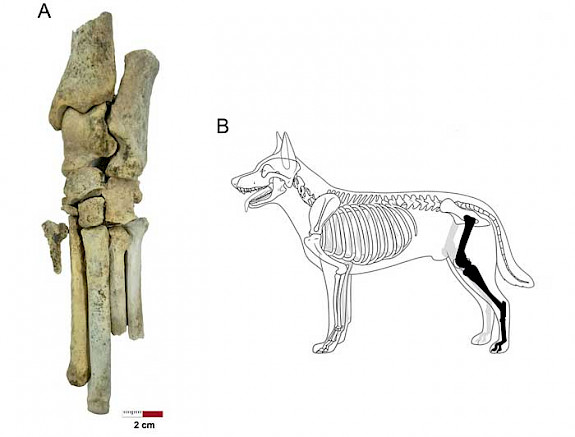The giant wolf (Aenocyon dirus) was a large extinct canid species that lived during the Pleistocene, mainly in North America, 14,000 years ago. With only a couple of fossil records in South America, this is the first time evidence of its presence has been found in Chile.
PUC Communications.- A multidisciplinary team made up of archaeologists, paleontologists and biologists have just published a scientific article in the Journal of Vertebrate Paleontology about the discovery of the first fossil of Aenocyon dirus, an ancestor of the current wolf that lived in the Pleistocene, 14,000 years ago. This is the first time that traces of a predator of these characteristics have been found in the national territory.
The located fossils correspond to bones of an incomplete hind leg and were found in the Quebrada Mani, located in the Pampa del Tamarugal, in the middle of the Atacama Desert. This evidence adds to the still scarce presence of remains of this species in the rest of South America. Related fossils have only been found in Bolivia, Argentina, Peru and Venezuela.
“It is the first record in Chile of this type of wolves. It is an animal with a wide presence in North America, for example in Rancho La Brea, Los Angeles, California, but very scarce in South America. In North America it is known what its diet was, its habits and with which current animals it is related. Further south, we only know that it should have reached Chile through the western part of the Andes mountain range. In general, all carnivores that inhabit today, including canids, come from North America, they are evolutionarily a foreign group. Despite being found throughout South America, the fossil record of canids is very difficult to find, except for some fossils. It is a good mystery”, comments Rafael Labarca, archaeologist, academic at the UC School of Anthropology, and part of the team that has achieved this important scientific event. Credits are also shared by UC academic Claudio Latorre. The scientific team in charge was led by the archaeologist from the University of Tarapacá Calogero Santoro.
«In general, all carnivores that inhabit today, including canids, come from North America, they are evolutionarily a foreign group. Despite being found throughout South America, the fossil record of canids is very difficult to find, except for some fossils. It is a good mystery»- Rafael Labarca, archaeologist, academic at the UC School of Anthropology
an extinct lineage
Until now, it is known that an ancestor of today’s canids quickly burst into South America about 3.5 million years ago, giving rise to a lineage that includes ten different species, including, for example, the culpeo and culpeo foxes. eared. However, the finding of this extinct wolf in Chile represents an important novelty since this line of canids, despite apparently having populated the entire subcontinent, did not diversify, maintaining its northern lineage. That is, it did not give rise to other native species.
“The difference between a wolf and a culpeo fox, for example, is that the former is eminently carnivorous, while the latter can be omnivorous. This extinct wolf had a hypercanivorous diet. It is the record of the largest extinct canid that has been found in national territory”, explains Labarca. The order Carnivora has several families: felids, ursids, mustelids, and canids, among others. In Chile there are fossils of cats, extinct bears and medium-sized canids, mainly in Patagonia. Thus, there were no representatives of this type of carnivores: the Aenocyon dirus. Until now.
a wet desert
14,500 years ago, at the end of the Pleistocene, a couple of wet events occurred in the current Pampa del Tamarugal. Scientifically called CAPE 1 and 2 – Central Andean Pluvial Event-, they implied that it rained a lot in the highlands and that the water began to go down the ravines, forming meadows and swamps. In the case that summons us, Mani stream, there is a fan where these waters discharged. This wetland attracted not only carnivores but also horses, sloths and camelids. “The chain between herbivores and carnivores had to be established. Who ate the megatherians or horses? At that time, there were no carnivores that hunted, for example, their young. We had an imbalance in the record from the end of the Pleistocene in Pampa del Tamarugal: many herbivores and few carnivores. It is true that there will always be more herbivores than carnivores in the landscape, increasing the probability that the fossils of those will be preserved over the latter, since it is directly related to the quantity. This research somewhat normalizes the old trophic chain in Pampa del Tamarugal”, explains Rafael Labarca regarding the importance of this discovery.
Regarding the way in which the bones of this wolf were found, the environmental conditions of the pampas helped especially. Sedimentation is scarce, with low erosion. Things can be on or very close to the surface for hundreds or thousands of years. This involves, by the way, a risk in view of the irruption of vans, whose tracks could also remain for a long time.
«In the desert it is a matter of walking and you can see the white bones on the surface; There are finds of megatherium bones, various remains of extinct horses, some camelid vertebrae, all around these wetlands, both in the Mani ravine and in other similar ones that must have had a common fauna. The record is so exceptional that in the pampas it is still possible to find the bases of the tamarugo trunks from those rainiest moments”- Rafael Labarca, UC Anthropology academic
“We have many points around these former wetlands full of animal fossils. We already have a mapping. Unlike Central Chile, where the paleontological sites are six feet deep, in the desert it is a matter of walking and you can see the white bones on the surface; There are finds of megatherium bones, various remains of extinct horses, some camelid vertebrae, all around these wetlands, both in the Mani ravine and in other similar ones that must have had a common fauna. The record is so exceptional that in the pampas it is still possible to find the bases of the tamarugo trunks from those rainiest moments”, says Rafael Labarca.
The investigation used an archaeological search model, which started with a geological and paleoenvironmental reconstruction in the Mani ravine, dating plant material and organic sediments, thus allowing clarity on the antiquity of these ancient moments of greater rainfall. Subsequently, a wolf fossil fragment was dated giving a result of 14,600 years old, which coincided with the first wet event (CAPE 1), which took place between 17,500 and 14,200 years ago. It is important to indicate that this fauna did not coexist with human groups, which were later. “In the central zone, similar predator remains have not yet been found. The sedimentation is much greater and the possibility of finding fossils, therefore, is infinitely lower”, concludes Labarca.





![[Img #74664]](https://thelatestnews.world/wp-content/uploads/2024/12/James-Watson-The-controversial-genius-behind-the-double-helix-150x150.jpg)








![[Img #74664]](https://thelatestnews.world/wp-content/uploads/2024/12/James-Watson-The-controversial-genius-behind-the-double-helix-300x200.jpg)

